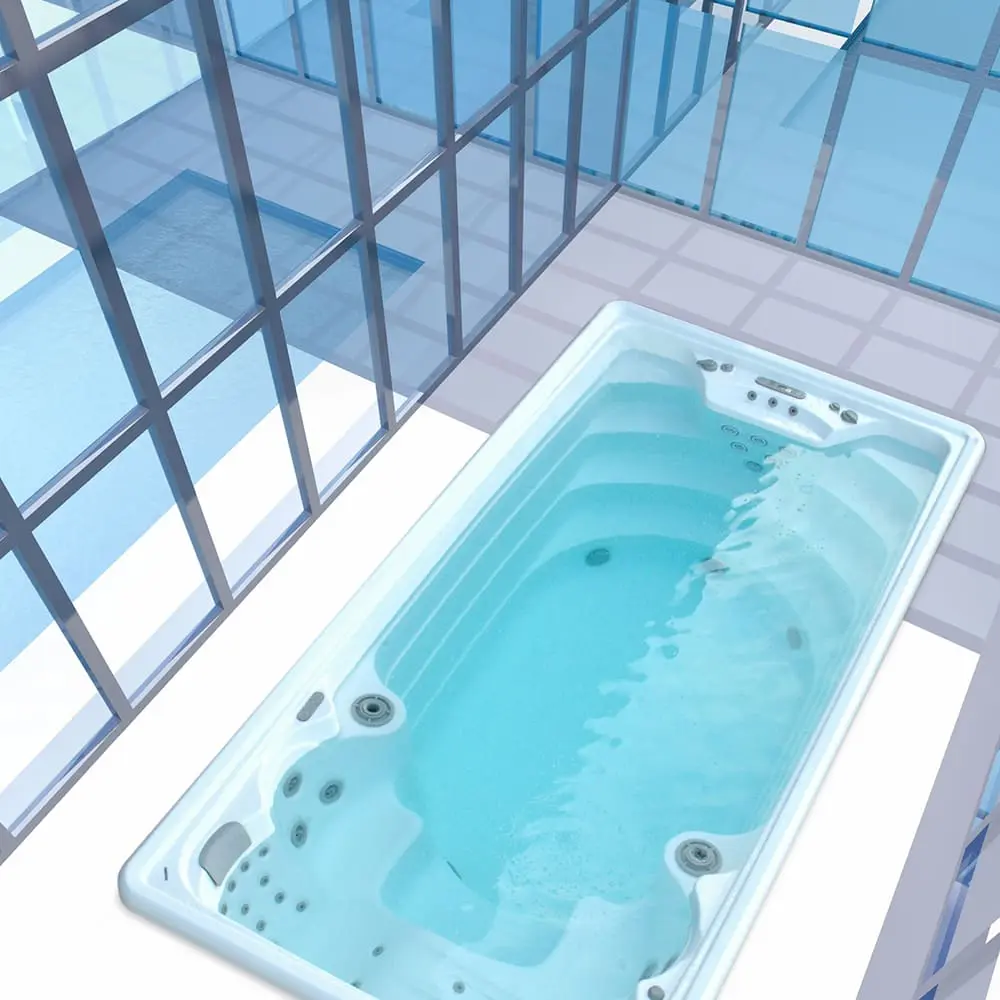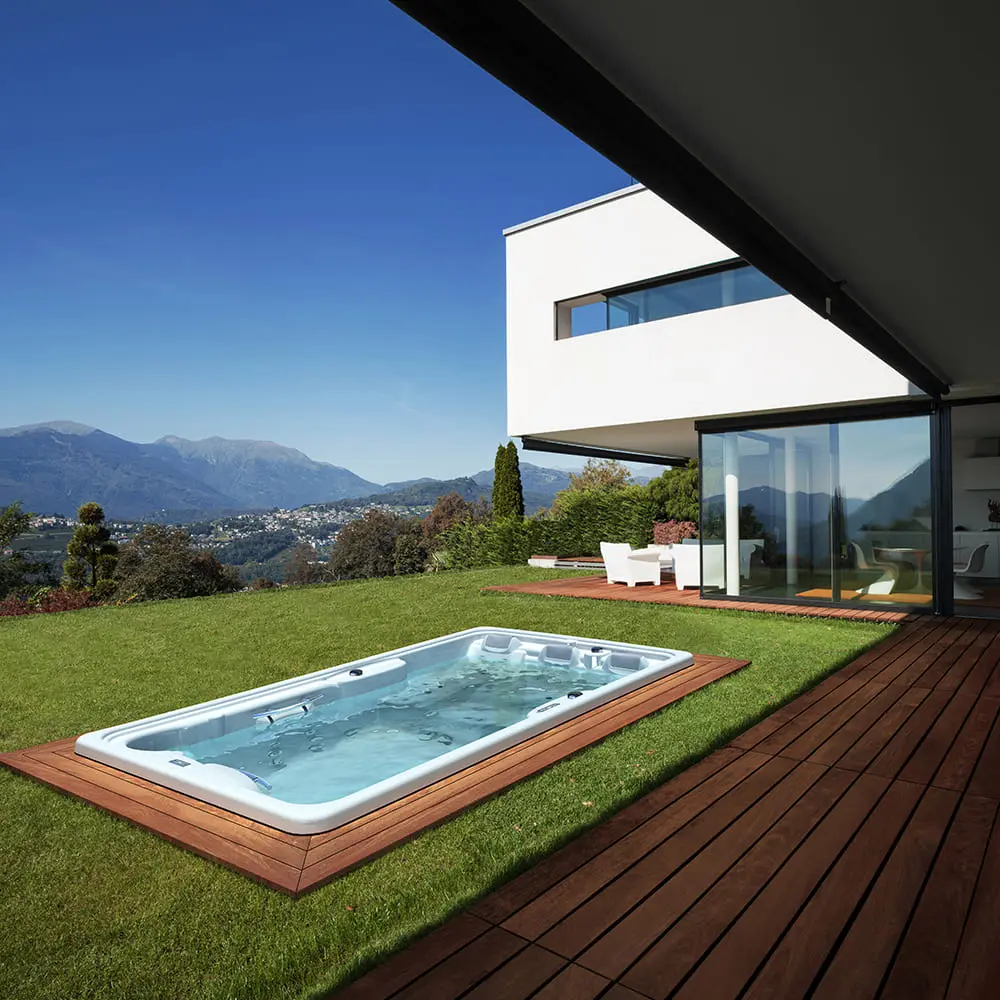Wellness centres have a wide range of pool types to allow end users to relax, exercise, or work on particular health concerns. One of them is the inground swim spa — a hot tub or a small pool with many features that enhance the visitors experience.
What are inground swim spas, what features do they offer and how can you add one to your commercial property?
Read on to find out:
- How swim spas work;
- Features of inground swim spas;
- What you need to consider when installing a swim spa.
Dive deeper with the eBook
What are inground swim spas?
We all know how hot tubs and spa pools normally work and look. A key element of wellness centres, sports clubs, city spas or hotels, is that they can also be found in private properties and they use water jets and other elements of leisure in the water.
The main goal of spa pools is to provide hydrotherapy — a holistic treatment used to relax and alleviate conditions including stress, anxiety and insomnia, and physical ailments such as bone and muscle injuries.
Inground swim spas are installed in the ground, as the name suggests. They offer the same hydrotherapy features of a portable prefabricated spa or a custom-design solution. Inground spas can be partially or fully recessed into the ground or lowered into a deck, allowing them to fit perfectly in the surrounding environment.
Spas installed into the ground provide a more integrated appeal to large wellness spaces with many treatment areas or water zones. In outdoor environments, it obtains a more ergonomic appeal with the surrounding landscape and architecture. On the other hand, in private areas such as suites in hotels or resorts, the above-ground spa tends to be the preferable option, but nowadays it is increasingly common to find inground installations there, too. They add value to the space, and they last for a long time.
Moreover, unlike “regular” spas or hot tubs, inground swim spas offer the best of both worlds —a spa and pool— all in one. They are a great way to relax, but thanks to the larger rectangular size, they can also be used for counter-current swimming through a special water jet system.


Swim spas key features
Swim spas can be built from stainless steel or acrylic reinforced with fibreglass. They fit indoors and outdoors in equal measure and usually feature a liner. Some acrylic models may also be coated in gresite ceramic tiles with custom-design patterns.
Here are the hydro-leisure elements you can usually expect from a swim spa:
- Water jets: relaxing but effective, the pressurised water jets release localised muscle tension and help with relaxation;
- Lighting / LED: underwater lighting is a key feature that enhances the spa effect;
- Air jets: softer and more delicate, these push air into the water to create a mix of bubbles and providing a tingling sensation;
- Piezoelectric buttons and sensors: interactive panel of switches to control the spa’s hydrotherapy system.
- Counter-current swimming equipment: an easy to install system that provides the pressure and thrust needed to practise swimming. It does not run off the pool’s hydraulic cycle. Pool water is sucked in through vents on one side and expelled through a nozzle at the centre of the front side. The direction and intensity of the water jet can be regulated by adjusting the nozzle control. An air valve, also situated on the front, regulates the flow of air bubbles into the water.
What does it take to install an inground swim spa?
Inground spa options are designed to blend into the landscape in which they are installed. An inground spa can be a stand-alone feature or integrated into an adjacent pool.
You should also be aware that a hot tub installed in the ground becomes a more permanent fixture of the landscape, so this can become an issue if you plan to renovate or move the spa.
However, if you are creating a long-lasting retreat, this installation can bring your vision to life. As you plan your project, here are some things to consider:
- Site preparation : any hot tub needs a solid foundation that can support the weight of the spa when filled with water. The same is true if you choose to put it in the ground. All types of inground spas (acrylic reinforced with fibreglass or stainless steel, public or private) need a concrete vault or slab under the basin to support the weight of the spa and to allow the proper space for the technical room. Some prefabricated models come with a plug & play structure with the water treatment kit included, usually in smaller hot tubs.
- Drains: partially or fully inground installations need a floor drain system installed in the concrete pad. This system should be designed to move any water that may collect away from your hot tub. This is of great importance because, if your site doesn’t drain properly, rain water can pool up and damage the spa.
- Access to the technical room is important when you are planning your hot tub installation, so take into account a little perimeter around the spa. You can maintain the inground spa look by adding decking and building a trap door for easy access to the components.
For users to obtain the full benefits of these facilities, maintaining the right hot tub temperature is vitally important. This needs to be kept between a minimum of 26°C and a maximum of 40°C for an ideal wellness experience. Additionally, any spa owner should have a pool cover. This will help spa water to keep some of its heat between uses and prevent debris from making their way into the water.
Finally, filtration is a key issue to be taken into account. Spa filtration systems are designed for heavy-duty use. Water is filtered through professional filter pumps and sand filters, complying with the strictest regulations and ensuring greater durability and reliability.
Conclusion
Adding an inground swim spa to a commercial property is an excellent way to combine the relaxing qualities of a hot tub with the option of swimming in the water for those who desire it.
With proper planning and preparation, an inground swim spa will fit into the environment and function seamlessly , as long as you take into consideration the few essential aspects outlined in this guide.
